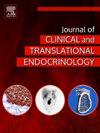Mild hyperprolactinemia in women with polycystic ovary syndrome. Insights from a large cross-sectional study
IF 3.3
Q1 ENDOCRINOLOGY & METABOLISM
Journal of Clinical and Translational Endocrinology
Pub Date : 2025-07-22
DOI:10.1016/j.jcte.2025.100412
引用次数: 0
Abstract
Background
Hyperprolactinemia is an exclusion criterion for polycystic ovary syndrome (PCOS), albeit PCOS itself is argued to induce mild hyperprolactinemia. We aimed to study the prevalence and causes of hyperprolactinemia in patients with PCOS.
Methods
We conducted a cross-sectional study including 336 premenopausal patients with PCOS and 90 nonhyperandrogenic controls referred to our clinics (referral population). We also studied an unselected population of premenopausal individuals who attended our center for voluntary blood donation (14 patients with PCOS and 207 non-hyperandrogenic controls). The main outcome measure was the percentage of individuals with hyperprolactinemia.
Results
As a whole, 39 out of 647 participants showed increased basal prolactin concentrations (6.0%, 95%CI: 4.4; 8.1) regardless of having PCOS or being a control, in both referral and unselected populations. In the referral population, 18 out of 31 individuals with hyperprolactinemia (58.0%, 95%CI: 40.8; 73.6) showed normal prolactin concentrations after appropriate resting, suggesting venipuncture stress-related hyperprolactinemia, and another nine participants (29.0%, 95%IC: 16.1; 46.6) did so after pre-analytical polyethylene-glycol precipitation of serum, indicating macroprolactinemia. There were differences in these figures between patients with PCOS and controls. In the unselected population, three out of eight participants with hyperprolactinemia (37.5%, 95%IC: 13.7; 69.4) had macroprolactinemia, and stress-related hyperprolactinemia accounted for another 62.5% (95%IC: 30.6; 86.3) of cases.
Conclusions
Hyperprolactinemia is equally likely among patients with PCOS and non-hyperandrogenic individuals. The most common causes of mild hyperprolactinemia in this population are venipuncture stress and macroprolactinemia that must not preclude a diagnosis of PCOS if suggested by signs and symptoms.
多囊卵巢综合征妇女的轻度高泌乳素血症。来自大型横断面研究的见解
背景:高催乳素血症是多囊卵巢综合征(PCOS)的排除标准,尽管PCOS本身被认为会诱发轻度高催乳素血症。我们的目的是研究多囊卵巢综合征患者高泌乳素血症的患病率及其原因。方法我们进行了一项横断面研究,包括336名绝经前PCOS患者和90名非高雄激素对照患者(转诊人群)。我们还研究了未选择的绝经前自愿献血人群(14名多囊卵巢综合征患者和207名非高雄激素对照组)。主要结果测量是高泌乳素血症个体的百分比。结果:总体而言,647名参与者中有39名显示基础催乳素浓度增加(6.0%,95%CI: 4.4;8.1)无论是否患有多囊卵巢综合征或作为对照,在转诊人群和未选择人群中。在转诊人群中,31例高泌乳素血症患者中有18例(58.0%,95%CI: 40.8;73.6)适当休息后催乳素浓度正常,提示静脉穿刺应激相关性高催乳素血症,另有9名参与者(29.0%,95%IC: 16.1;46.6)在分析前聚乙二醇沉淀血清后出现这种情况,表明大量催乳素血症。这些数据在多囊卵巢综合征患者和对照组之间存在差异。在未选择的人群中,8名参与者中有3名患有高泌乳素血症(37.5%,95%IC: 13.7;69.4)有大催乳素血症,应激相关性高催乳素血症占62.5% (95%IC: 30.6;86.3)例。结论高催乳素血症在PCOS患者和非高雄激素个体中的发生率相同。轻度高催乳素血症最常见的原因是静脉穿刺压力和大量催乳素血症,如果体征和症状提示,不能排除多囊卵巢综合征的诊断。
本文章由计算机程序翻译,如有差异,请以英文原文为准。
求助全文
约1分钟内获得全文
求助全文
来源期刊

Journal of Clinical and Translational Endocrinology
ENDOCRINOLOGY & METABOLISM-
CiteScore
6.10
自引率
0.00%
发文量
24
审稿时长
16 weeks
 求助内容:
求助内容: 应助结果提醒方式:
应助结果提醒方式:


